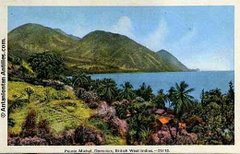
Will Dominica gain more than it loses from the installation of an oil refinery?
A Discussion of the Facts
1. What is an oil refinery?
Fact: An oil refinery is typically a large scale plant that processes a hundred thousand to several hundred thousand barrels of crude oil per day. Because of the high capacity, many units are operated continuously at steady state or approximately steady state for long periods of time (months or years). (Wikipedia)
Note: The Minister has indicated that the proposed refinery will process ten thousand barrels of oil a day.
Fact: The major products of an oil refinery are: asphalt, diesel fuel, naphtha, fuel oil, gasoline, kerosene, jet aircraft fuel, liquid petroleum gas, lubricating oils, paraffin wax and tar. (Wikipedia)
Fact: The typical oil refinery includes the following process units: desalter, atmospheric distillation, vacuum distillation, naphtha hydrotreater, catalytic reformer, distillate hydrotreater, fluid catalytic cracking, hydrocracker, merox treater, coking, alkylation, dimerization, isomerization, steam reforming, storage units, amine gas treater, claus, cooling towers, waste water collector and treatment systems, boiler plants. (Wikipedia)
Fact: Oil refineries need large amounts of electricity and water to operate. Typically, they use thousands of gallons of water daily (20 gallons per barrel of oil).
Fact: Oil refinery operations require storage of huge amounts of oil and oil products. Because of its need to operate constantly, an oil refinery must have a large volume of oil on hand. The industry standard is 3 month’s supply. Once the oil is processed, the products must also be stored until they are sold.
Fact: According to the Minister of Housing, Lands, Telecommunications, Energy and Ports, the Honourable Reginald Austrie, the proposed oil refinery will occupy 25 acres of land.
2. Where will the oil refinery be located?
Assumption: Because of the need to transfer oil and the refinery products to and from ships, the refinery would have to be located on the coast. The west coast is likely the only suitable location for such transfers to occur given the roughness of the sea to the east.
3. What are the terms of investment?
Not revealed by Government to date.
Fact: President Chavez has pledged at least US$47 billion in aid and agreements to a variety of countries. Economists predict that the country’s resources will not be adequate to honour all of these commitments.
4. What commitment will be expected from Dominica?
Not revealed by Government to date.
5. Who will own the refinery? If it is a company, who owns the company?
Not revealed by Government to date.
6. Who will manage the refinery?
Assumption: There are no Dominicans with the expertise to manage an oil refinery. The expertise will have to come from overseas.
7. Who will maintain the refinery?
Assumption: Expertise to perform maintenance does not exist locally and will have to come from overseas
8. Who will oversee the refinery’s operations to ensure it is controlling pollution?
Fact: Dominica’s Government does not have the capacity to regulate this operation.
9. Who will buy the oil, sell the processed products and earn whatever profits are made?
Not revealed by Government to date.
10. To what extent and how will the profits benefit the people of Dominica?
Not revealed by Government to date.
11. To what extent can Venezuela guarantee that oil will be available to the refinery over a period of time on advantageous terms?
Fact: Dominica has no oil of its own and will have to buy oil to refine, if any is available
Fact: Venezuela is bound by its OPEC membership to charge the OPEC price.
Fact: The world’s oil supply is quickly reaching peak production. Experts predict that within fifteen years, the world’s extra oil supply is likely to come from expensive and environmentally damaging unconventional sources, such as Venezuela’s Orinoco tar belt. (Financial Times, February 18, 2007)
Fact: Venezuela is making similar deals with other countries, including some large Latin American countries, countries with larger populations and more industry and who share Venezuela’s cultural and linguistic heritage. (Washington Post, February 23, 2007)
Fact: The demand for oil from fast-growing and very large economies, such as those of China and India, is going to keep the cost high for the foreseeable future.
12. How would Dominica enforce promises given by Venezuela’s present government should power there change hands?
Fact: Inflation is said to be skyrocketing in Venezuela - so much so that President Chavez has recently threatened to nationalize grocery stores if the owners did not limit their price increases. (Washington Post, February 23, 2007)
Assumption: President Chavez may not remain in office if the conditions in Venezuela deteriorate significantly. His successor may not feel bound by promises he has made.
13. What are the kinds of catastrophic accidents that can occur at oil refineries?
Fact: Fires and explosions are not uncommon incidents at oil refineries. These incidents may threaten the lives of persons living in the vicinity as well as persons working in the refinery. For example, on Saturday, February 17, 2007, the Associated Press reported that an explosion rocked a west Texas refinery the day before injuring at least nineteen and sparking a blaze that sent a huge black cloud billowing into the sky.
Fact: Refineries are also a source of large chemical releases during fires, explosions, upsets and spills. During these accidents, many thousands pounds of dangerous chemicals can be released in a short period of time. These dangerous spills often dump chemicals into the communities around refineries causing health problems. For example, on February, 23, 2007, the Associated Press reported that BP had settled several lawsuits from an explosion in their Texas plant in 2005. In that explosion, 15 people were killed and 170 were injured, a thousand claims were filed and 500 lawsuits remain outstanding. Two-thirds of the lawsuits were for personal and property damage that occurred outside the refinery.
Fact: Most refinery air pollution is from product leaks in equipment not smokestacks. (Refinery Reform Movement)
14. To what extent has the Government considered the possibility of hurricane or earthquake damage to the refinery resulting either in making the refinery inoperable of causing pollution?
Fact: Dominica is vulnerable to earthquakes, hurricanes and volcanic eruptions.
15. To what extent has the Government looked at the need to develop the necessary emergency response services should any kind of accident, explosion, fire, oil spill or chemical leak occur at the refinery?
Fact: Dominica presently has no capacity to deal with the kind of catastrophic event that occurs from time to time at oil refineries.
16. Has the Office of Disaster Preparedness been consulted about the potential hazards that an oil refinery may pose?
Not revealed by Government to date.
17. Exactly how will the oil refinery result in the reduced cost of electricity?
Not revealed by Government or by DOMLEC to date.
18. What other options to reduce the cost of electricity that pose less threat to the environment have been considered or pursued?
Fact: Dominica is blessed with an abundance of potential alternative renewable energy sources, including wind, solar, tide, biomass and geothermal.
Fact: Wind and solar energy produce no pollution.
Fact: Wind and sunlight are free and in abundant supply in Dominica.
Fact: It only takes three to eight months for a wind energy farm to recoup the investment in building and installation (National Resources Defense Council)
Fact: Venezuela, Cuba and China are investing in wind and solar power as means to reduce oil usage.
19. What is Dominica’s energy policy?
Fact: As recently as April, 2006, the Government said at an Alternative Energy Symposium that its strategy was to develop clean energy.
Fact: Dominica has no formally adopted policy on energy. The public has not been informed about the Government’s position with respect to the OECS energy policy discussions or the status of any clean energy initiatives.
Fact: Dominica has been a participant in CARICOM’s Caribbean Renewal Energy Development project since 1998.
Fact: Dominica is part of a project being carried out by the Renewable Energy & Energy Efficiency partnership (REEEP) entitled Accelerated Use of Sustainable Energy in the East Caribbean, which is designed to develop 10MW of clean energy for the country.
Fact: Dominica is eligible to participate in the OAS initiative, Renewable Energy in the Americas, which provides a variety of assistance for developing geothermal as well as solar and wind energy.
Fact: The public is not informed about the status of these projects, how Dominica is taking advantage of them or what is needed to move them forward.
20. Has the Government thought through what is Venezuela’s reason for wanting to establish an oil refinery on the Nature Island?
Fact: President Chavez has made no secret of his intention to replace the influence of the United States in the Caribbean and Latin America. Building oil refineries in the region takes business away form the U. S. and the multinational companies.
Fact: No new oil refineries have been built in the United States since 1976 because of concerns related to the pollution they produce and the environmental hazards they present to neighbouring communities. (Wikipedia)
Fact: Venezuela is struggling to reduce its very significant problems with air pollution and would not want to aggravate the problem by building more refineries there.
21. Has Government considered the potentially negative impact of this arrangement on its relations with the United States?
Assumption: While there may be benefits to be gained by Dominica from participating in this effort, there are very likely to be repercussions as well, and Dominicans need to be aware of what those may be.
22. What is the technology proposed to be used in the oil refinery?
Not revealed by Government to date.
23. What kind of pollution will the oil refinery produce when operating properly?
Fact: The refining process releases numerous different chemicals into the atmosphere, consequently there are substantial air pollution emissions, and a notable odor normally accompanies the presence of a refinery. Aside from air pollution impacts, there are also waste water concerns, upset risks of fire and explosion, and both occupational noise and environmental noise health effects. (Wikipedia)
Fact: According to the U.S. Environmental Protection Agency, oil refineries produce the following air pollutants: particulate, sulfur oxides, carbon monoxide, hydrocarbons, nitrogen oxides, aldehydes and ammonia.
Fact: Refineries also generate a lot of toxic waste in solid form that must be disposed of. The average refinery generates 10,000 gallons a day of waste that contains toxic chemicals known to cause cancer, birth defects and other serious health effects. (Communities for a Better Environment)
Complied by Betty Perry-Fingal – as a work in progress, open to corrections and additions
March 14, 2007
Thursday, November 15, 2007
Betty Fingal's Oil Refinery Discussion
Posted by
Jen Miller
at
2:06 PM
![]()
![]()
Labels: Oil Refinery
Subscribe to:
Post Comments (Atom)














2 comments:
Excellent work, Jen, on this compilation of facts! I agree with the findings but can also appreciate the propaganda finesse of this post. ;-)
All credit goes to Betty Fingal!
Post a Comment